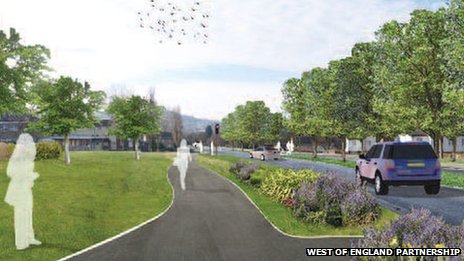Bristol is, I think — and have mentioned here many times — one of the top three least worst cities for cycling in the UK. They understand there that it is the danger and discomfort posed by motor traffic that prevents people from cycling, and it is their steady expansion and improvement to traffic-free routes that enabled a near doubling of cycle modal share for commuting since the 2001 census, to what is, by Britain’s risible standards, a relatively respectable 8%.
And this last week the city invoked jealous looks from the rest of the country on twitter when it opened the consultation on the latest in its long backlog of cycle network infrastructure projects: a proposal for what it describes as a “Dutch-style” bidirectional cycle track alongside a main road and the New Cut of the River Avon a little way south of the city centre. Not because the few hundred metres of cycle track are in themselves all that revolutionary, but because they saw a city quietly getting on with it, happy to replace car parking spaces with cycling infrastructure, and with little of the “Crossrail for bikes”-style hype.
So it should be a subject of great embarrassment for Bristol that at the same time as designing “Dutch-style” cycle tracks that take space from motoring on Clarence Road, it is finalising planning permission for the next Facility Of The Month alongside a big new ringway road — dressed up as a Bus Route — a couple of kilometres to the south.
The latest visuals of the South Bristol Link Road are strong contenders for the most ridiculous artist’s impression of a new road yet — and gosh does that prize have some competition.
And amongst the wildflower meadows and sylvan glades of this new paradise, where morning motorists will no doubt be serenaded by songbirds as they speed uninterrupted through the city like they were promised in the car commercials, pedestrians and cyclists will be treated with utterly contemptuous shared pavements.
A nineties throwback, a footway with a white line down it, interrupted by every driveway and sprawling side-road. Straight out of the government’s Manual for Crap Facilities.
Elsewhere Bristol is learning the lesson that much of its first generation cycle infrastructure — the Railway Path, the quaysides, and many dozens of “fiddly little bits” documented in detail by Sam Saunders — is proving inadequate, victim of the city’s small success, as their insufficient capacity and lack of clarity creates conflict between users. Which is why the city is learning to build “Dutch-style” clear cycle tracks — Clarence Road being the latest of a series.
And it’s why it’s so galling to see a proposal for something not even up to standards of that first generation of infrastructure. A facility that is, at best, worthy of Birmingham or South Gloucestershire.



“worthy of Birmingham or South Gloucestershire”
oh, the sting of shame!
Good work Joe.
“one of the top three least worst cities for cycling in the UK” Like it :-)
At very first glance that rapid transit picture doesn’t look too bad, cycle lane and pavement set away from the road, a more reasonable allocation of road space to cars.
Then I realised there isn’t actually a cycle path on the other side of the road, would like to see two bikes passing without cycling on the pavement. Then what I thought were drive way access (where the cycle lane has priority !!) are actually parking bays, less than one per house hold, because the average car ownership rate is less than one per house hold and dropping thanks to amazing cycle provision. I’m also puzzled as to how bus stops are going to work, I’m going to take a wild guess and say they won’t be taking more space away from the main carriage way.
I’m also impressed by the massive pedestrian islands, that’ll be fun with a pram, lorry one side, and bus the other.
Seeing only the diagram, one does wonder what they can do better without removing the parking bays on at least on side of the road. :O
It’s nice that all those houses in the diagram have little walls across the front of their garden, to show the impossibility of people using their own property to store their own property.
The parking bays are marked to indicate that the cars are welcome on the pavement, including the green bits.
How does a cyclist get from the side road to the so-called ‘cyclepath’ (shared use, grrr!) opposite without risking life and limb?